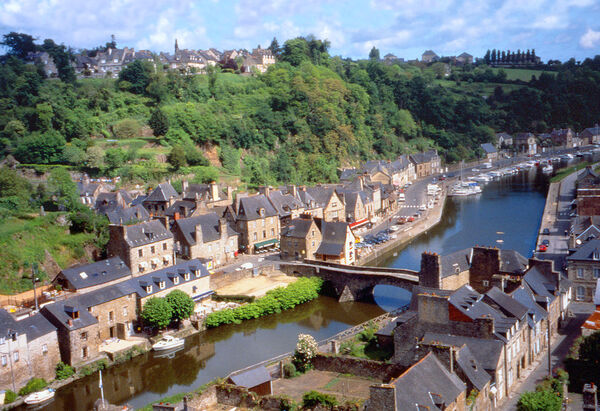Doing Brittany’s Dinan
By Rick Steves and Steve Smith
If you have time for only one stop in Brittany, the photogenic peninsula in France's far northwest, make it the ancient riverfront city of Dinan. By train it's less than four hours west of Paris and two from Mont St-Michel, but it seems a world away.
While simply charming today, Dinan was once a formidable city — a residence of the duke of Brittany, a strategic port on the English Channel, and a trading center with powerful guilds and good connections with England and Holland. In the 13th century, ships outgrew its river port, the harbor action migrated to nearby St-Malo, and the town center moved uphill and behind defensive fortifications.
Dinan's hefty ramparts now bundle its half-timbered and cobbled quaintness into Brittany's best medieval town center. While it has a touristic icing — plenty of crêperies, shops pedaling local kitsch, and colorful flags — it is also clearly a workaday town filled with about 10,000 residents who appreciate their beautiful, peaceful surroundings, and take pride in their distinct Breton culture. Music stores, for instance, sell more Celtic music than anything else.
It's hard to imagine that this music was forbidden as late as the 1980s. During that repressive time, many of today's Breton pop stars were underground artists. And not long ago, a child would lose French citizenship if christened with a Celtic name, as the French nation had long sought to squelch the centuries-old quest for Breton independence. But today the locals — many with red hair and freckles — are free to wave their flag, sing their songs, and speak their language (there's even a Breton TV station and radio station). Browsing shops full of whimsical, uniquely Breton souvenirs, and bakeries specializing in Breton treats, is one of the joys of a visit here. Try the richly indulgent kouign amann, a puffy, caramelized-butter cake, or a gâteau breton, a traditional shortbread cake.
Dinan isn't about museums, castles, or other must-sees. The attraction is the town itself, impeccably preserved after escaping the bombs of World War II. Enjoy the old town center, ramble around the ramparts, and explore the old riverfront harbor.
The heart of Dinan's historic center is Place des Merciers, still lined with picturesque half-timbered buildings, many sporting ground-floor wooden porches. They date from the time when property taxes were based on the square footage of the ground floor. Medieval shopkeepers started with small ground floors, then expanded outward into upper floors, while selling their goods in front of their homes under the shelter of their leaning walls. On some of Dinan's narrower lanes, the roofs lean out across the street far enough to nearly touch.
Between Place des Merciers and the town walls stands the quirky St. Sauveur Basilica. It's gangly and terribly asymmetrical, inside and out, having been built in many stages over the centuries (its oldest parts date back nearly a thousand years). Inside, an old wood balcony above the entry heaves under the weight of its organ, while striking modern stained-glass windows beautifully light the nave.
The strollable parts of Dinan's stout, mile-long ramparts are like an elevated parkway, and lined by private gardens. Given a chance to replace their venerable walls with a wide, modern boulevard, the people of Dinan chose instead to keep their slice of history (and the traffic congestion that comes with it).
A short walk beyond the walls leads down to the river and the city's once-thriving old port. For centuries, this is where Dinan's people lived and worked, and today it's a great place for a riverside drink or meal. But the best thing about Dinan's port is the access it provides to lush riverside paths that amble along the gentle Rance River Valley. You can walk, bike, drive, or boat in either interesting direction (perfect for families).
For a breath of fresh Brittany air and an easy walk, head upriver to visit the flower-festooned village of Léhon. Or you can rent a bike at the port and pedal there — the Rance River Valley could not be more bike-friendly, as there's nary a foot of elevation gain.
Fifteen miles downriver lies St-Malo, perched right where the Rance River meets the sea. This beach resort, with another walled-in old town, is worth at least a few hours' visit. You can reach it most scenically via a 2.5-hour river cruise run by Compagnie Corsaire (the bus back to Dinan takes less than an hour).
Whether at the riverside or up in the town center, Dinan has good restaurants for every budget. Since galettes (savory crêpes) are the specialty, crêperies are a nice, inexpensive choice — and available on every corner. Be daring and try the crêpes with scallops and cream, or go for the egg-and-cheese crêpes.
Wash them down with the locally produced hard apple cider, traditionally served in handpainted bowls. After your second bowl, your tongue may be loosened up enough to try some Breton — why not start with "Yec'hed mat!" (cheers)?
Steve Smith is the co-author of the Rick Steves France guidebook.


